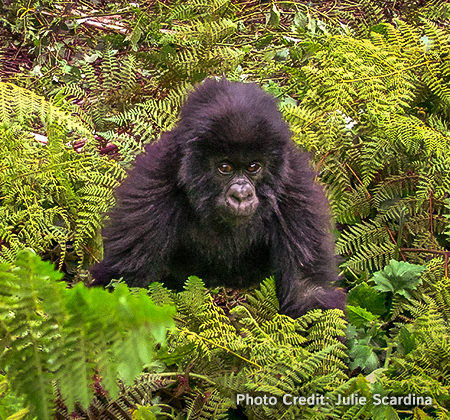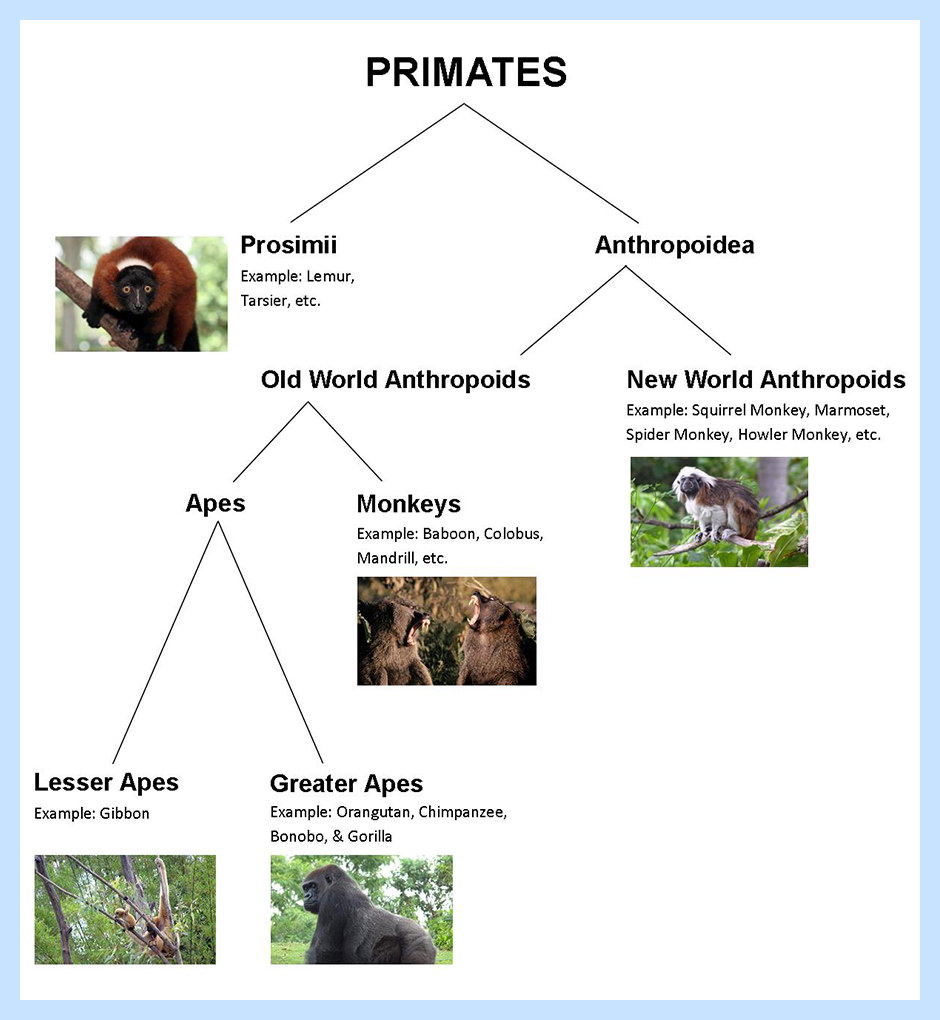Kingdom - Animalia
Phylum - Chordata
Class - Mammalia
Mammals are characterized by the following features:
- Mammals breathe air with lungs.
- Mammals are "warm-blooded": they maintain a constant, high body temperature independent of their surroundings.
- As a rule, mammals bear live young. (Two primitive mammals are exceptions to this rule: the duckbilled platypus and the spiny anteater/echidna both lay eggs).
- Mammals nurse their young with milk.
- Mammals have hair, at least at some stage in their development. A whale's smooth skin is an adaptation for swimming. A newborn calf often has a few sparse hairs around the rostrum that are lost within the first days of life.
Order - Primates
The scientific order Primates encompasses about 233 living species classified in 13 scientific families. Most primates live in tropical forests and vary greatly in size. The smallest primate member is the pygmy mouse lemur (Microcebus myoxinus) weighing around 31 g (1.1 oz.) and the gorilla is the largest primate weighing up to 220 kg (484 lbs.).

Family - Hominidae
Historically humans and their extinct ancestors were classified in the Family Hominidae while all great apes (chimpanzees, bonobos, gorillas, and orangutans) were classified in the Family Pongidae. However, biomolecular and genetic research along with recent fossil evidence have identified new similarities between species, leading to the reclassification of chimpanzees and gorillas into the Family.
Genus, Species - Gorilla & beringei
In the past, gorilla scientific classification had one species (gorilla) that was divided into three subspecies. Each of these subspecies was distinguished from one another by their geographic location in Africa.
- Western lowland gorilla (Gorilla gorilla gorilla) is the smallest of all three subspecies — weighing around 180 kg (396 lbs.) for an adult male — and lives in the tropical forests of West Africa. Lowland gorillas in general are similar in appearance. The western lowland gorilla is the most common type of gorilla found in zoological facilities and is the species cared for at Busch Gardens Tampa Bay.
- Eastern lowland gorilla (Gorilla gorilla graueri) is slightly larger in size weighing up to 220 kg (484 lbs.) and darker in coloration than the western lowland gorilla. They live in the rainforests of central Africa.
- Mountain gorilla (Gorilla gorilla beringei) is the largest and rarest of all three subspecies. Adult males may weigh over 227 kg (500 lbs.) They are found at high elevations of the Virunga Volcano range that separates Democratic Republic of the Congo from Rwanda and Uganda. Their hair is longer and darker than their lowland counterparts due to the colder climate of the high elevation. Mountain gorillas are taller, have a more pointed head, have a wider gap in the middle of the nose, and lack a reddish patch of hair on their heads, common to lowland gorillas.
In 2001 mitochondrial DNA research and morphological variances have led to the scientific reclassification of gorillas. Under the new classification gorillas are divided into two species, the eastern gorilla (Gorilla beringei) and the western gorilla (Gorilla gorilla). It is thought that the two species diverged from one another about 2 million years ago and both have two subspecies.
- The eastern gorilla's two subspecies are the eastern lowland gorilla (Gorilla beringei graueri) and the mountain gorilla (Gorilla beringei beringi).
- It has been suggested that there is a third subspecies of eastern gorillas because a small subset of mountain gorillas that inhabit the Bwindi National Park in Uganda possess distinctive characteristics such as morphology, ecology and behavior. Due to the small size of mountain gorilla populations and available samples for testing, it is difficult to determine whether the two populations are physically and genetically distinct enough to be considered two separate subspecies.
- The western gorilla's two subspecies are the western lowland gorilla (Gorilla gorilla gorilla) and the Cross River gorilla (Gorilla gorilla diehli).

Nomenclature
The name "gorilla" was derived from an ancient account by a Carthaginian explorer who sailed along the west coast of Africa nearly 2,500 years ago. Local people shared their name for the great ape with him — the rough translation of which meant "hairy person".
Mountain gorillas live around the Virunga Mountain Range. Virunga translated means "a lonely mountain that reaches the clouds".
Phylogeny
Primates may be divided into two suborder groups.
- Prosimii (prosimians)
- Prosimians are said to be primitive because some of their physical characteristics are found in other mammals but are generally not shared in other primates. For example prosimians have a nose structure that remains moist, called a rhinarium (also found in dogs), that enhances their sense of smell.
- Anthropoidea (non-prosimian primates)
- Anthropoids are further divided into New World & Old World anthropoids. New World anthropoids are native to North & South America whereas Old World anthropoids are native to Africa & Asia.
- Apes are further divided into greater & lesser ape categories. Lesser apes include the 11 recognized species of gibbons and siamangs native to Southeast Asia. Greater apes are native to both Africa and Asia, and include orangutans, chimpanzees, bonobos and gorillas.

Apes diverged from Old World monkeys about 25 million years ago. There are many differences between apes and monkeys, including the following characteristics:
- Apes have no tail
- Apes usually have a larger body size & weight
- Apes have more of an upright body posture
- Apes have broader chests
- Apes rely more on vision than on smell (have a short broad nose rather than a long snout)
- Apes have longer gestations and need longer periods of time to mature.
- Great apes tend to be less arboreal (tree-dwelling) and more terrestrial (ground-dwelling). This has led to many changes in the muscle and skeletal structure of their arms because they are not as adapted for tree-dwelling (brachiation - swinging from trees) as monkeys are.The fossil record indicates that lesser and greater apes diverged from one another about 18 million years ago. The Pongidae family (orangutans) diverged about 14 million years ago, gorillas about 7 million years ago, and chimpanzees and humans diverged about 6 million years ago.
- Humans have about 98.4% of our DNA (deoxyribonucleic acid - genetic material) in common with chimpanzees. This genetic information has provided insight to human-relatedness to other great apes such as the gorilla. Humans are more closely related to chimpanzees and gorillas than either of them are to orangutans.



Discovery of the Modern Gorilla
According to the fossil record, ape descendants originated in Africa more than 25 million years ago and then dispersed throughout Asia and Europe.
Over 15 genera of apes have been identified by paleontologists to have lived during the Miocene Era (23 million years ago) in places such as Italy and Greece.
Nearly 2,500 years ago an expedition from the Phoenician merchant city of Carthage to western coasts of Africa accidentally discovered a group of wild gorillas.
During the sixteenth century an English sailor by the name of Andrew Battel was captured by the Portuguese in West Africa. He spoke of two man-like apes (today easily recognized as chimpanzees & gorillas) that would visit the campfire when it was unattended.
The mountain gorilla was first discovered by a German officer, named Captain Robert von Beringe in 1902. Prior to this time, only lowland gorillas were known to exist. The mountain gorilla subspecies name is derived from Captain Robert von Beringe's last name (Gorilla beringei beringei).
Evolutionary Perspectives of the Gorilla
Many ancient explorers and African tribes have described gorillas as primitive hairy people. They have also been referred to as anthropoid or "man-like" apes.
During the 1600s very little was known about apes and scientific literature often confused the greater apes with pygmy tribesmen.
In 1860 an explorer named Du Chaillu described the gorilla as a bloodthirsty forest monster that is willing to attack any human beings. Author Alfred Brehm discounted Du Chaillu's claim in the 1876 book, Thierleben (Animal Life).
The gorilla's intimidating appearance, extreme strength, and chest-beating displays have given them an unfortunate and inaccurate ferocious stereotype. Several mainstream movies have perpetuated this false stereotype, resulting in misconceptions as to gorillas' true gentle nature.
The first documented gorilla research was in 1959 by George Schaller. His book was entitled The Year of the Gorilla. This was one of the first books that dispelled many myths such as the savage nature of gorillas.
In 1963, Dian Fossey began her study, research and conservation of mountain gorillas. In 1983, she published a book entitled Gorillas In The Mist. In 1986, a movie based on her book brought gorilla conservation to worldwide attention.



